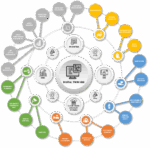
Designing Eco-Friendly Elevators for Modern Buildings
Most of us step into and out of elevators on a regular basis without thinking twice about how they work or how efficient they operate. However, it’s some engineers’ jobs to determine how eco-friendly building elevators are and how they can be designed to be greener.
Industry experts have estimated that buildings consume about 40 percent of the world’s energy, and elevators account for up to 10 percent of building energy use. There are lots of moving parts in an elevator that contribute to overall efficiency: the materials, technologies, paint, flooring, lighting, and HVAC systems.
Here are a few of the most important components that make elevators environmentally sustainable and the technologies that make them work.
Machine Room-Less System
One of the most significant advances in elevator technology took place in the 1990s, thanks to innovations in less bulky equipment. Instead of having a huge machine room to hold all the equipment, elevators now have everything they need right in the elevator shaft. These types of elevators can use up to 80 percent less energy than hydraulic lifts or cylinders filled with oil underground.
Double Deck Elevators
Double deck elevators can help save energy because one cab stops on even-numbered floors and one stops on odd-numbered floors. This is a great option for mid-rise and high-rise buildings that are capable of high speed operation. This technology helps reduce the number of stops and complements the other control systems noted below.
Computerized Control Systems
Did you know that elevators carrying fewer passengers actually use more energy than ones that are packed to capacity? Eco-friendly elevator systems aim to control traffic and limit interior lighting to save energy on light loads. Computerized systems help make this possible, while still operating fast enough to serve the needs of busy buildings.
In-Cab Sensors
Buildings that are equipped with energy efficient elevators are now equipped with in-cab sensors as well. These sensors and accompanying software allow elevators to enter an idle mode when not in use. This means that the lights turn off, the ventilation system slows down, the music stops, and the video screens turn off when the elevator is empty.
Destination Dispatch Software
No one likes to wait longer than necessary for an elevator because it’s making unnecessary stops on empty floors. Destination dispatch control software helps to solve this problem by combining elevator stop requests in batches. Not only does this minimize wait time in buildings but it also reduces the number of elevators that are needed in a particular building.
Regenerative Drive Systems
Engineers are also designing eco-friendly elevators that actually recover used up energy and put it to use again through the building’s electrical system. This helps buildings conserve power use during peak periods of time and reduces the need for machine room cooling. Not only does this prevent buildings from wasting energy, but it also helps owners and management companies save money.



